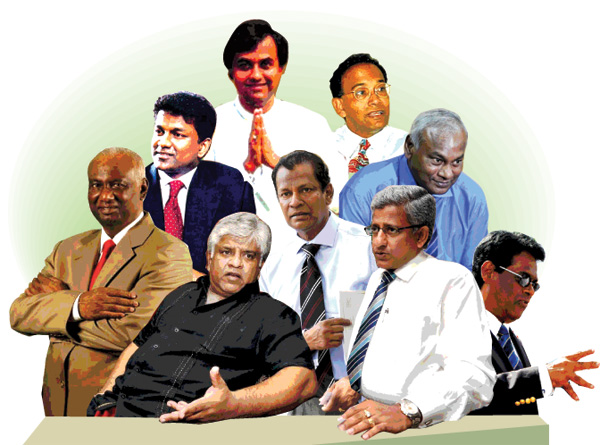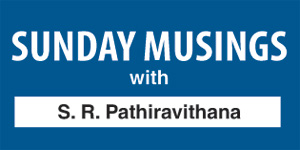Dudes and Dons of cricket
View(s): Through the travails of life down the order in the annals of our little nation, we have had many kings with strong-character — like Walagamba and Gemunu — and weaker characters in the calibre of Yasalalakatissa and Don Juan Dharmapala.
Through the travails of life down the order in the annals of our little nation, we have had many kings with strong-character — like Walagamba and Gemunu — and weaker characters in the calibre of Yasalalakatissa and Don Juan Dharmapala.
Of course still their names are discussed in various situations and for different reasons. May be those are some of the highs and lows in our history.
Today’s narration is not based on Lankan kings of yesteryear. It is about how a few strong-willed individuals have impacted the game of cricket in the country and how the actions of some weaker links (the meaning to this description of a weaker link may come in different contexts according to the situations) in the midst have also impacted the game. It is also about how the game has drifted towards being a political tool through the actions of both these types.
The story begins in the mid-seventies or the early eighties when a career politician – Gamini Dissanayake who had not played the game in a big way — got interested in the game especially under the tutelage of former All Ceylon off spinner-turned-cricket-administrator Abu Fuard. It was the era when the International Cricket body was of the view that Sri Lanka was not ready to be a competent member of the big league.
 It was an effective combination of two strong people with strong character. Yet, it was Gamini Dissanayake who took the Lankan cause up with the International Cricket Conference which was then controlled by Australia and England. Then with strong support by our neighbours, India and Pakistan, Gamini Dissanayake took Lankan cricket to the higher plane and won a seat in the executive committee in cricket’s hallowed forum in 1981. At that point Gamini Dissanayake was the President of the Board of Control for Cricket in Sri Lanka and he held that post till 1989. Sri Lanka played its first Test match against England at the P. Saravanamuttu Stadium in 1982. Gamini Dissanayake took over the reins once again in 1994, but, his sudden demise that November saw the two vice-presidents — Ana Punchihewa and Upali Dharmadasa — taking Lankan cricket along without the aid of an Interim committee till the next annual general meeting was held in February 1995.
It was an effective combination of two strong people with strong character. Yet, it was Gamini Dissanayake who took the Lankan cause up with the International Cricket Conference which was then controlled by Australia and England. Then with strong support by our neighbours, India and Pakistan, Gamini Dissanayake took Lankan cricket to the higher plane and won a seat in the executive committee in cricket’s hallowed forum in 1981. At that point Gamini Dissanayake was the President of the Board of Control for Cricket in Sri Lanka and he held that post till 1989. Sri Lanka played its first Test match against England at the P. Saravanamuttu Stadium in 1982. Gamini Dissanayake took over the reins once again in 1994, but, his sudden demise that November saw the two vice-presidents — Ana Punchihewa and Upali Dharmadasa — taking Lankan cricket along without the aid of an Interim committee till the next annual general meeting was held in February 1995.
Ana Punchihewa was elected President of the BCCSL. At the same time, there was another twist in the set-up. It was the emergence of Thilanga Sumathipala as vice-president along with Upali Dharmadasa. This ambitious youngster stopped at nothing. At the very next AGM, Punchihewa who was celebrating Sri Lanka’s first major achievement — the Cricket World Cup 1996 — was thrown out within two weeks of the epic event and Upali Dharmadasa was installed as President. However, the architect in this Brutus affair was Sumathipala who by then had the support of the then Sports Minister S.B. Dissanayake and the Lankan cricket captain Arjuna Ranatunga.
After his two-year term Upali Dharmadasa was never voted into power again. Sumathipala usurped power and took control of the Board of Control for Cricket in Sri Lanka. Yet, by this time his friendship with the Ranatungas had gone sour and it was not too long that the Lankans had their first experience with Interim Committees with famous Banker Rienzie Wijetillake being appointed to head it. Yet, it was not a secret that the aggrieved party in this instance was Ranatunga and the political party in power was the party that the Ranatunga family had association with.
Sumathipala always looked beyond the horizon. While in power he increased the cricket vote base by almost fifty by introducing the District and Provincial setups and these constituencies had a vote each. Besides, these rural bases were the cradles for budding politicians who began to cut their teeth in the game’s administration which by this time had become a global entity and a money spinner.
This gave him somewhat the political support he wanted, but it was insufficient for him to carry on for two years by extending his one-year term. The government in power always looked to an excuse to get him out of power through the formation of an Interim Committee, but, at the very next election, with the support of the system that he had built up, he walked back to power.
By this time, besides the loyalists, he also had accumulated many foes who included the Ranatungas, Dharmadasas, the guy next door who didn’t have the guts or the wherewithal to oppose the gaming baron at the game of cricket elections and even some in the ICC. So much so, the ICC gaming resolution barred a seat for Thilanga at the ICC even if he was elected in Sri Lanka.
But, in 2004, his cricket ploys went awry when he was taken into custody over an alleged passport fraud. Then the mantle was taken over by his long-time confidant Mohan de Silva and at the next AGM, de Silva was elected President – uncontested. But, it was not a secret that even at that time Sumathipala had a huge hold on the day-to-day proceedings of the SLC.
Then in 2005 once de Silva’s term was over, Sumathipala wanted to contest; the result was the formation of the long-drawn government-controlled interim committees which kept Sri Lanka’s cricket in the hands of politicians till 2011. With the interim committees came the guys next door with the support of the government in power. First it was rather laid back Jayantha Dharmadasa (2005-2007) who had to make way for Arjuna Ranatunga who always eyed that position. It was a kind of payback for his political somersault that pulled the young Rajapaksa government out of a tight corner.
The government control of cricket continued blatantly and when Arjuna Ranatunga was removed from his position, the then Sports Minister took the bold step of appointing a government servant in S. Liyanagama. In March 2009 cricket once again was handed over to cricketers and the new Interim Committee Chairman was former Sri Lanka Leg spinner who played the country’s inaugural Test match – D. Somachandra de Silva. But, more significantly it was Arjuna Ranatunga’s younger brother Nishantha who was appointed as secretary of this committee.
Generally the Ranatunga family had a very close association with the UPFA government and the senior Ranatunga, father of the siblings, Reggie already had held a ministerial post in the Chandrika Kumaratunga government. Nishantha first came into prominence after he was appointed the Director General of the Rupavahini Corporation in the early part of the PA government.
Once in the Cricket Interim Committee, Nishantha gradually began to override the administratively weaker de Silva. But, the duo took upon the challenge of taking the Lankans through the hosting of the 2011 ICC Cricket World Cup where Sri Lanka was a co-host. Towards this exercise, the SLC went on a building-spree putting up new stadia in Pallekelle and Hambantota and completely revamped the facility at the R. Premadasa Stadium.
Co-hosts India and Sri Lanka emerged winners and runners-up of the tournament, but, after going through such a lucrative tournament the Lankans ended up in the red, unable to pay the creditors amid allegations of corruption over the stadium constructions. Under sheer pressure of the aggravated situation, the Interim Committee was dissolved and another was installed with Upali Dharmadasa making a comeback. But Sports Minister Mahindananda Aluthgamage who took over the reins in November 2010 kept his faith in the Ranatunga sibling.
Unlike his brother Arjuna who went for a head-on confrontation with the Indian Cricket authority, especially N. Srinivasan, Nishantha forged a friendship with the India’s cricket strongman. By this time he was almost in control of the running of the SLC. It was at this point that the ICC put pressure on the Lankan cricket authority to go in for democratic cricket elections.
The so-called democratic elections were held in Sri Lanka, but, under government pressure both key positions of President and secretary went uncontested and both Upali Dharmadasa and Nishantha Ranatunga were installed as President and Secretary. In the next election, it was the same story, but, instead of Upali, his brother Jayantha was given the opportunity to take the hot seat, but, Nishantha came in uncontested as secretary, courtesy Aluthgamage.
Then it was the race for the 2015 cricket elections – the first true democratic elections (If you could call it so, owing to campaign that the prospective candidates had gone through to woo the stakeholders). After 2004 this was going to be the first occasion where the stakeholders were getting the opportunity of electing an administration without someone driving the two top positions down their throats. The primary contestants were Jayantha Dharmadasa and Nishantha Ranatunga.
It was a major flare-up. Neither contestant wanted to take a step backwards. But, seemingly it was the Nishantha camp that held the advantage where vote count was concerned. However, by then Nishantha who had taken over the control of the administration also had built his own share of enemies. They came from various quarters which even included some of the leading players in the national team.
To make a long story short, the result was another interim committee. Now the question is: Does this system really work for Sri Lanka? The system will always produce characters like Thilanga Sumathipala and Nishantha Ranatunga. Can the political system teach them a lesson by appointing interim committees? When would the Lankan system rid its political patronage?


